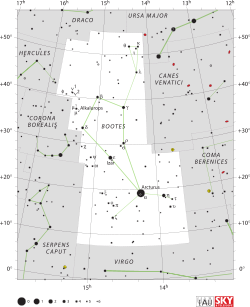Boötes
| Constellation | |

|
|
| Abbreviation | Boo |
|---|---|
| Genitive | Boötis |
| Pronunciation | /boʊˈoʊtiːz/, genitive /boʊˈoʊtᵻs/ |
| Symbolism | the herdsman |
| Right ascension | 13h 36.1m to 15h 49.3m |
| Declination | +7.36° to +55.1° |
| Family | Ursa Major |
| Quadrant | NQ3 |
| Area | 907 sq. deg. (13th) |
| Main stars | 7, 15 |
|
Bayer/Flamsteed stars |
59 |
| Stars with planets | 10 |
| Stars brighter than 3.00m | 3 |
| Stars within 10.00 pc (32.62 ly) | 3 |
| Brightest star | Arcturus (α Boo) (−0.04m) |
| Nearest star |
Wolf 498 (17.71 ly, 5.43 pc) |
| Messier objects | 0 |
| Meteor showers | |
| Bordering constellations |
|
|
Visible at latitudes between +90° and −50°. Best visible at 21:00 (9 p.m.) during the month of June. Other designations: Arctophylax |
|
Boötes /boʊˈoʊtiːz/ is a constellation in the northern sky, located between 0° and +60° declination, and 13 and 16 hours of right ascension on the celestial sphere. The name comes from the Greek Βοώτης, Boōtēs, meaning herdsman or plowman (literally, ox-driver; from βοῦς bous “cow”).
One of the 48 constellations described by the 2nd-century astronomer Ptolemy, Boötes is now one of the 88 modern constellations. It contains the fourth-brightest star in the night sky, the orange giant star Arcturus. Boötes is home to many other bright stars, including eight above the fourth magnitude and an additional 21 above the fifth magnitude, making a total of 29 stars easily visible to the naked eye.
In ancient Babylon, the stars of Boötes were known as SHU.PA. They were apparently depicted as the god Enlil, who was the leader of the Babylonian pantheon and special patron of farmers. Boötes may have been represented by the foreleg constellation in ancient Egypt. According to this interpretation, the constellation depicts the shape of an animal foreleg.
The name Boötes was first used by Homer in his Odyssey as a celestial reference point for navigation, described as "late-setting" or "slow to set", translated as the "Plowman". Exactly whom Boötes is supposed to represent in Greek mythology is not clear. According to one version, he was a son of Demeter,Philomenus, twin brother of Plutus, a ploughman who drove the oxen in the constellation Ursa Major. This is corroborated by the constellation's name, which itself means "ox-driver" or "herdsman." The ancient Greeks saw the asterism now called the "Big Dipper" or "Plough" as a cart with oxen. This influenced the name's etymology, derived from the Greek for "noisy" or "ox-driver". Another myth associated with Boötes tells that he invented the plow and was memorialized for his ingenuity as a constellation.
...
Wikipedia
